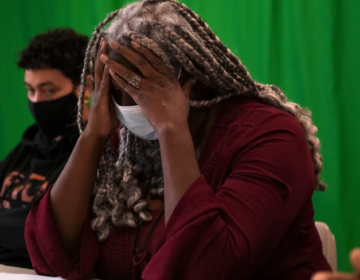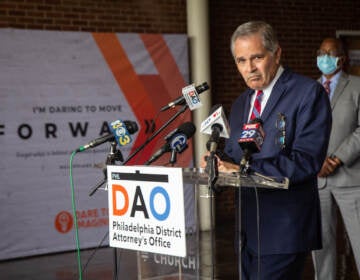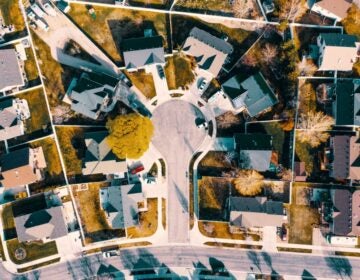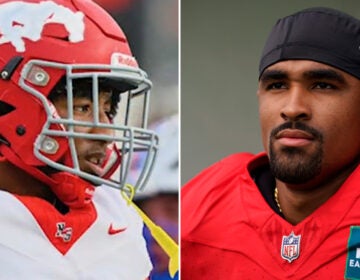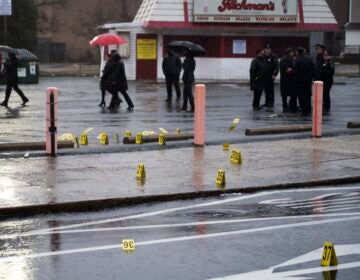Philly ends 2021 with over 550 people murdered. But community leaders say a ‘peace movement’ is building
It’s an enormous loss, mostly of young Black men. Some Philly antiviolence activists point to new efforts to stop the shooting block by block as a sign of hope.
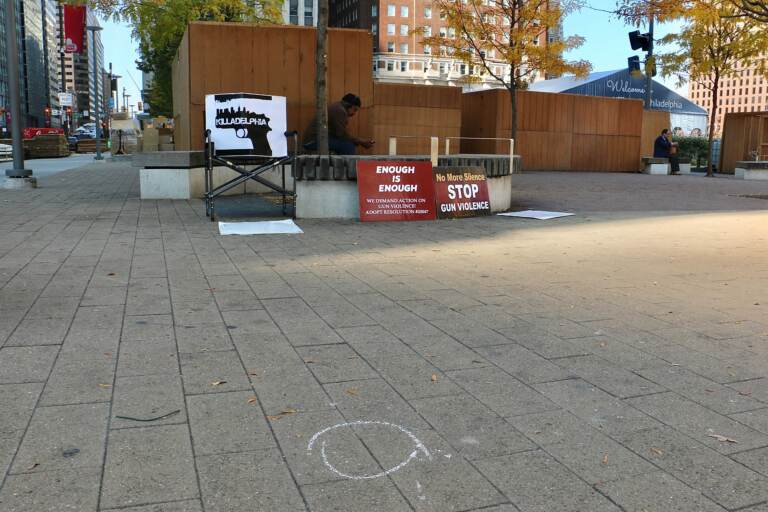
File photo: A chalk circle marks the place where a bullet casing landed during a fatal shooting in LOVE Park. (Emma Lee/WHYY)
There’s a proverb that Tommy Joshua Caison, a faith-based organizer from North Philadelphia, likes to quote when discussing how to get the city out of its gun violence crisis.
“It says, what’s the best way to eat an elephant? And the answer to that is, bite by bite,” Caison said. “We certainly believe bite by bite, block by block, come in with a heart for the people … will actually help to head off violence.”
Caison has been thinking a lot about that proverb as the end of 2021 draws closer. More than 550 people have been murdered this year in Philadelphia.
It’s an enormous loss — mostly of young Black men. People who were students, parents, and friends, leaving many other people who cared about them behind to grieve, and community leaders and politicians frustrated by what they say has been a lack of urgency at all levels of government to respond to the epidemic.
It’s a loss far greater than in any year since 1960, when police first began tracking killings in the city. Close to 2,000 others have been shot and survived. And now, elected officials and community leaders say they’re trying to figure out a way to make sure 2022 doesn’t bring more of the same.
At a press conference at the District Attorney’s Office Thursday — officially called in order to exhort Philadelphians not to shoot off celebratory gunshots on New Year’s Eve — an array of public officials and community leaders were all in agreement that any real solution has to come from within the community, bite by bite and block by block.
“It really is going to take the community to get involved,” said Catherine Hicks, who heads the Philadelphia NAACP and attended the event. “We are partnering with some of the organizations like Philly Truce, like Life Outside the Streets, and some of the other boots-on-the-ground groups who are connecting with some of these young shooters and some of the communities that are really at high risk.”
This isn’t a new idea, but officials say they’re hoping to systematize the community-based approach in ways they haven’t before.
One initiative they think has some promise is Partners in Peace, a collaboration between Caison’s group Philly Peace Park and the longstanding youth shelter and nonviolence organization House of Umoja.
Inspired by a truce House of Umoja brokered among dozens of gangs in 1974, the coalition called a ceasefire in West Philly’s Carroll Park neighborhood ahead of Thanksgiving, and has now followed it up with another, broader ceasefire — this time targeted at neighborhoods in Northwest Philly, Kensington, and Germantown, as well as West Philly.
The group is attempting to deploy what Caison calls the “10-10-10 Plan,” in which it sends 10 teams of 10 people to 10 different blocks to negotiate ceasefires with local people known to be involved with shootings.
Sen. Sharif Street (D-Philadelphia) says he’s been watching these kinds of outreach efforts.
It’s difficult to call ceasefires in Philly, he said, because “we don’t have, like in a city like L.A., just two big rival gangs. We have lots of really small interpersonal disputes that are happening where five guys from this corner are angry with four people over that corner,” he said. “We have lots of people who are very well armed and are having lots of disputes.”
But he has seen promising results from focused, granular efforts — like the peace walk that residents of North Philly’s Richard Allen, Penn Town, and Harrison housing communities held last year.
“At a micro level, yes, those ceasefires work,” Street said. “But to scale that stuff up requires a significant amount of resources. And you got to identify the right personnel to do it.”
Caison says he thinks his group’s early results have been promising. During the Carroll Park ceasefire, which ran from Nov. 22 to 29, there were no shootings.
He acknowledges there have been more since the ceasefire ended, but he believes the rate has slowed.
“One of the mistakes that was made in the 1974 gang truce was that there was no high command or no mechanism to monitor the actual continuation of it,” he said. “So we have made sure that we have built organizations in each neighborhood. The peace patrols will continue.”
Caison is generally skeptical of city officials “just dump[ing] money into a problem;” the city has committed $68 million for violence prevention. But he says he’s pretty confident in this approach, and that for the kind of longer term work he’s hoping Partners in Peace can do with these continued peace patrols, and with maintaining these 10 person intervention teams, he’s hoping for some institutional support.
Already, he says, they’ve started working with a lot more local groups.
“That’s what we’ve seen with round number two” of the ceasefire, he noted. “More community organizations have adopted the peace patrol model, have adopted the peace treaty model of, ‘We’re going to actually sit people down. We’re actually going to do the hard work of identifying the conflicting parties, and we’re going to work to bring them to a table of peace.’”
Bilal Qayyum, a longtime antiviolence advocate and head of the Father’s Day Rally Committee, says he feels reason to hope that 2022 will bring a reduction in the shooting.
Qayyum has been involved in violence intervention for a long time. He was part of the House of Umoja’s ceasefires in the 1970s, and says it stands alone in his memory as a successful initiative for one key reason: “because of the community stepping up, taking responsibility.”
“In 1979, there were zero gang deaths in this city,” he said. “I know that every time the community steps up, takes responsibility, hits the streets, does intervention, we see a change.”
Now, he says, he feels that desire for change again.
“There is, in 2022, clearly a sign of more to community-based organizations working together,”
WHYY is your source for fact-based, in-depth journalism and information. As a nonprofit organization, we rely on financial support from readers like you. Please give today.



